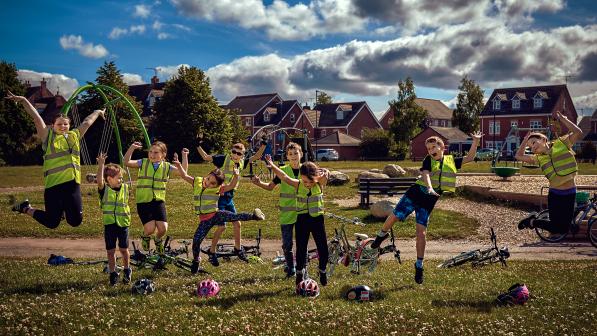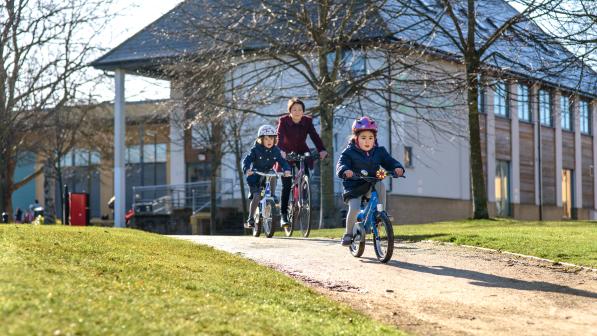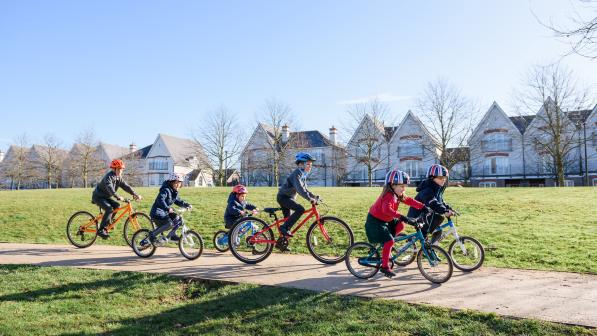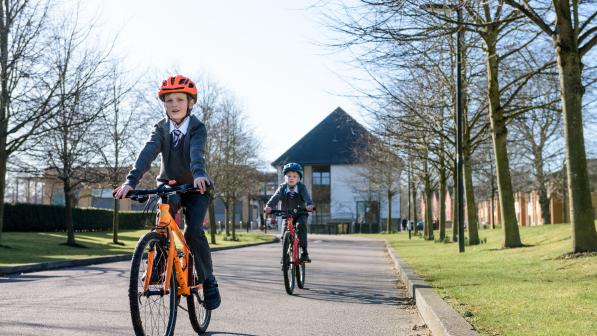Cycling to school: a 'right' of passage

At the age of around 16, I began cycling to my school in Glasgow, the only pupil at the time to do so. My bicycle offered me both freedom and independence, and I was soon cycling everywhere; to friends’ houses, to the park, into town. I never looked back, and I carried the habit on to London when I moved south for university. Those early commutes set me up for life: my bike remains my go-to transport for almost every journey I make.
As my own experience proved, schools are perfectly positioned to normalise cycling as the first-choice form of transport for children. However, despite this golden opportunity, around just 2% of children in the UK cycle to school, a number which has remained stagnant for years. Opportunities to change habits can be few and far between, but last summer, with lockdown freeing up safe space on the roads for family cycling, cycling levels skyrocketed, with the number of children between five to 11 cycling for fun or fitness increasing by 18.4% according to a Sport England survey, while polls found cycling to be the most popular family activity at the time.

Locking in this change would massively help shift school-run travel habits, and the payback could be huge: Cycling UK's own research shows that a boost to cycling levels would benefit children’s physical and mental health, their concentration in the classroom, and offer financial savings for parents, environmental benefits and economic growth to the entire country
With their ability to ingrain habits at an early age, schools may also be part of the solution to overcoming one of the cycling community’s biggest challenges – a lack of diversity. Low cycling levels amongst women, black and ethnic minorities (BME) and low-income groups arises from embedded social and cultural barriers, with BME and low-income group consultations showing that many people from these backgrounds “don’t know anyone who cycles”. Instilling a love for cycling at an early age will help ensure that all children grow up surrounded by cyclists, and this could represent a significant step forward in overcoming this persistent challenge.
However, with traffic now back up to pre-pandemic level, the opportunity is slipping away rapidly, and all too often, we see that's it's schools themselves making things difficult.
One step forward, two steps back
Unfortunately, the safety fears which have built up thanks to decades of car focussed investment have recently triggered a concerning trend of cycling bans being implemented in some schools over recent years.
The policies vary from one school to the next, but a standard example from one school in April this year was a 'ban' on bringing cycles into the school if children didn't wear a helmet.
Although there’s no doubt the school in question was acting with the best intentions, these policies symbolise one possible end game of the Government’s "windscreen perspective" – a world in which the entire onus for cycling safety is put on cyclists, and one in which cycling is often considered so dangerous that it simply cannot be permitted. Meanwhile, motor vehicles – the source of the danger – are catered to with seemingly endless investment in car friendly infrastructure.
If these policies become more widespread, they could have a devastating impact on the development of a cycling culture in the UK - meaning even less children cycling to school, and more car traffic, contributing further to the source of the danger, as opposed to reducing it.
The indirect impact will be even worse: by reinforcing the idea that cycling is an inherently dangerous activity and putting the onus of safety on pupils, as opposed to motor vehicles and poor road design, these policies further ingrain a subconscious association between cycling and danger which is currently the biggest barrier to cycling in the UK.
The direct impact: less children cycling, unhealthier children
As far as helmets are concerned, the reality is that there is no clear evidence to support the safety benefits of helmets – with various studies showing that they are certainly not the magic wand waving a spell of protection over their wearer as sometimes made out to be. This informs Cycling UK’s policy on helmets, which is one of simple choice: parents should be trusted to know what is best for their children.

On the other hand, there is certainly clear evidence to show that obligatory helmet rules seriously affect cycling uptake. States and cities which have implemented helmet laws have seen a 30-40 per cent reduction in cycling levels. In Sydney, the introduction of such laws triggered a 90 per cent fall in the number of teenage girls cycling. Here in the UK, only 20 per cent of girls currently meet the government’s physical activity recommendations, but girls who cycle to school regularly are seven times more likely meet those targets.
Mandatory helmet rules within a school community will therefore trigger a significant reduction in cycling levels among young people, while potentially doing nothing to improve the safety of cycling. This is a genuine disaster in terms of public health, not to mention the financial impact it may have on families.
The indirect impact: the "cycling is dangerous" myth ingrained in another generation
These rules also feed into the victim-blaming rhetoric surrounding cycle safety, which actively frustrates attempts to tackle the underlying dangers on our roads.
Of course, cycling carries risks. But so does walking. In fact, for every mile travelled, you’re more likely to be killed as a pedestrian than a cyclist. Yet if a headteacher banned pupils walking to school without a helmet, and threatened to confiscate their shoes should they fail to do so, they would become a laughingstock.
In focussing their energy on helmet use, schools mislead children and parents as to the realities of cycle safety, and suggest responsibility lies at the door of cyclists, not the drivers who knock them down. This in turn allows lawmakers and highways authorities to deflect their responsibility to fund safe cycling infrastructure.
This misconception creates a negative feedback loop which will forever restrict the development of a cycling culture: schools put the onus of safety on pupils, no action is taken to tackle dangerous driving or poor road design, avoidable cyclist deaths and serious injuries continue, fuelling the perception of cycling as being inherently dangerous, leading schools to enforce helmet or Hi-Viz use, restarting the loop.
To compound this, research has found that where more cyclists are present in an area, injury rates generally fall, as drivers become more aware of cyclists and local authorities begin investing in safer infrastructure. By putting off significant numbers of potential cyclists, schools leave those who continue to cycle at increased risk.
What is to be done?
Sadly, it's not just schools who are failing to embrace the potential of a school run revolution - many councils are also letting down children. Across the UK, councils were given extra money by national governments during lockdown to create safe space for active travel, to enable people who started cycling to continue doing so. Sadly, however, we've seen some councils remove these cycle lanes just at the time when they're needed by children to get safely to and from school.
Take Brighton and Hove Council, for example, which created a well-used cycle lane along the Old Shoreham Road last year, linking together a number of large schools and offering 6,000 pupils a safe route to their school gates. Despite evidence that the lane encouraged many people out of their cars an onto bikes, and had limited impact on congestion, the council decided last month to remove the cycle lane altogether, just before the schools returned.
Sadly they're not the only council to do so - Cycling UK is currently taking West Sussex County Council to court over a similar knee-jerk decision made in response to a small minority of loud voices.
If we want to give parents the confidence to allow their children to cycle to school, safe routes to and from school are absolutely vital, and governments must do more to ensure local authorities integrate routes to and from schools into active travel plans, and push ahead with interventions to make cycling safer, even if they have to put up with a vocal minority of opposition.

Equally, schools must see themselves as part of the solution, and work to promote cycling, not restrict it. Schools should apply for Bikeability classes to be provided, or support their teachers to become qualified Bikeability instructors (which is possible through the proceeds of the "Sugar Tax" at primary schools), and can also look to projects such as Play on Pedals for inspiration on cycling development, which saw over 7000 preschool children in Glasgow partake in training days to get them cycling, allowing them to experience first-hand the fun side of cycling.
So, if the government wants to be serious about safe cycling – and to be serious about children’s health – it must abandon its "windscreen perspective" and put forward significantly increased investment into cycle friendly projects across the country, enabling schools to focus on developing children’s love for cycling from a young age, helping them discover a hobby which can offer happiness and good health into adulthood and beyond.






